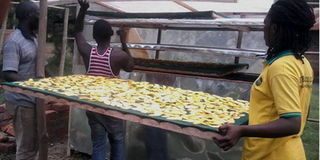Preserving pumpkins to make more money

The drying process of pumpkins can take up to a week.
What you need to know:
- Fatuma Namutosi realised that pumpkins were more than a food crop and could fetch more money if they were turned into products. She shares her story with David Mafabi
Many farmers in Uganda still earn little from their produce as they are still stuck in the cycle of selling it in raw form. Usually farmers are forced to sell off their produce even when the prices are low because they are perishable.
Fatuma Namutosi, a graduate of Social Sciences from Islamic University in Uganda, then working as a news anchor at Step Television in Mbale District discovered that most of the farmers lack storage facilities that can extend the produce’s shelf life and usually lacked knowledge to add value to the crop.
In 2015, she set out to bring back the long time forgotten pumpkin to people’s dining tables with simplicity in preparation, with added value to increase incomes for rural farmers through low cost of production and ready market.
Getting started
“I realised that processed organic foods are on demand and farmers needed protection from middlemen. We had a pumpkin garden at home. I tried selling the fruit but I was not breaking even yet I was also incurring transport costs,” she shares.
Armed with Shs 500,000, she says she travelled to Kayunga and bought dried pumpkins from a farmer at Shs40,000 and grinded it into flour in Mbale, bought millet flour at Shs60,000 and Soya bean flour at Shs 120,000 packed it. “All this plus labour and packaging cost about Shs 550,000 and I sold it to friends and fetched about Shs1.2 million,” she says.
Not to incur costs of rent, Namutosi utilised a small room at her family home in Bungokho-Mutoto, Mbale District. She sold the idea to other local youth farmers on the village. Armed with knowledge from the Kayunga District farmers, Namutosi sensitised the others on the benefits of working together to add value to their agricultural products before selling them.
Most youth resisted the initiative, claiming it was an expensive venture and only two were willing to join her.
They formed a small food processing business called Byeffe, a Lumasaba word that literally means ours. Namutosi, who is Byeffe’s director, says the main objective of forming Byeffe was to save farmers, who were being cheated by middlemen. To ensure that she was a good resource, Namutosi enrolled for a short course in nutrition at the School of Food Technology Nutrition and Bio engineering in Makerere University to assist as well as teach others to mix the different ingredients to formulate nutritious food products.
She maintained her family pumpkin garden and now gets more produce from local farmers within Bugisu, Bukedi and Teso areas.
Turn around
She visited farmers with different types of crops in Mbale District and discovered that they grew passion fruits, bananas, carrots, cabbages, soy beans, millet, bananas, onions, and tomatoes, among other others, but that they had given up on growing pumpkins because of the low prices they fetched.
But before the following season began, she conducted research on how to process flour from pumpkins.
She remembers spending sleepless nights reading any available literature on pumpkins she discovered pumpkins were traditionally embraced as medicinal foods. Namutosi also visited different websites on the Internet carrying out research on which products she could make from pumpkins. “I then came across this; that one can actually make flour, wine, peanut butter as well as food spices from pumpkins,” she adds.
That is when she started to look for commercial food processing plants to compare prices.
Motivation
Namutosi says the cost of a big pumpkin in most villages is about Shs1,000 during harvest season at the farm gate while half a kilogramme of pumpkin flour is Shs5,000. “A farmer usually throws away pumpkin seeds yet from one pumpkin one can harvest seeds that can fill two tins, she says. A tin of roasted pumpkin seeds goes for Shs4,000. “I discovered that a farmer loses about Shs8,000 by failing to add value and not utilising the seeds,” she adds.
For instance, a farmer was selling a pumpkin at Shs1000 to middlemen but when that farmer dries the pumpkin and sells to us, they are paid Shs 6,000 for each kilogramme.
Two raw pumpkins make one kilogramme of dried pumpkin, he adds. So, by simply drying the pumpkin, a farmer gets Shs5,000 more.
Ripple effects
Namutosi started by making 50kg of flour but currently she processes 20,000kgs quarterly. This is what she sells to her more than 10,000 customers. She says that through partnerships, they have now ably enrolled more than 3,000 youth.




